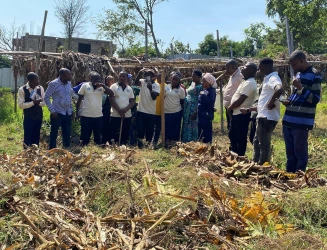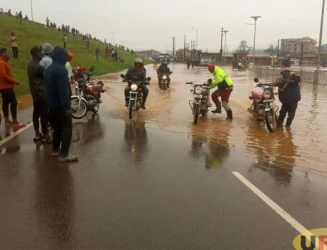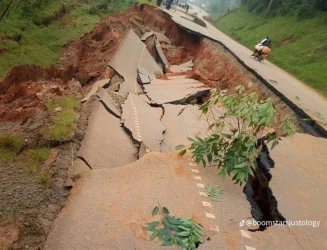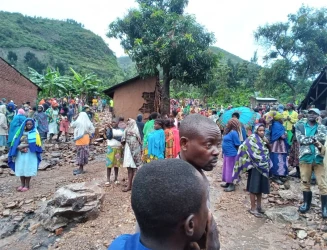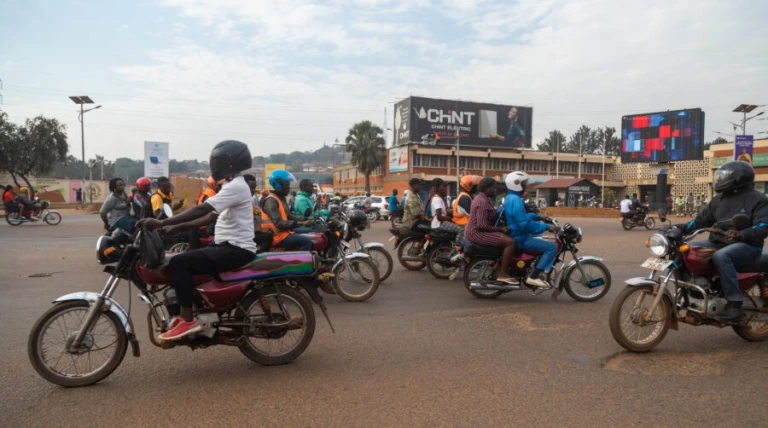
A Story of Uganda’s Extreme Temperatures backed up by Floods.
Introduction.
For Joseph, a farmer in Uganda’s Luwero district, the last two months have felt like a nightmare. The sun hung unforgivingly in the sky, burning the earth beneath it. The temperature rose to 40°C in Uganda as reported by Daily Monitor on February 24, 2025, in March Kenya also recorded temperatures going to 40°C and in Rwanda it heated to over 27°C and the land, once lush with green, was now a vast stretch of cracked soil. Every morning, Joseph walked to his small banana plantation, only to be met with wilting crops, the leaves curled and browned from the relentless heat. His cows, once strong and healthy, had begun to grow weak from dehydration. He knew he wasn’t alone. Across Uganda, Rwanda, and Kenya, communities were battling the same unforgiving sunshine.
This is not just Joseph’s story, it’s the reality for millions of East Africans who have faced one of the hottest seasons in recent history. As temperatures finally begin to drop, and late March downpours bring slight relief, many are left wondering: What caused this? What damage has been done? And most importantly, how can we prevent this from happening again?
The experience: Surviving the heat.
In Kampala, students struggled to concentrate in classrooms that felt like ovens. Schools that could afford fans ran them at full speed, while others had to let students out early to escape the unbearable conditions. In hospitals, doctors saw an increase in heatstroke and dehydration flu and cough cases due to the dust, especially among the elderly and young children. Taxi drivers and boda boda riders, who spent their days under the scorching sun, felt dizzy from heat exhaustion but had no choice but to keep pushing.
Towards the end of March, Uganda started experiencing devastating floods due to heavy rains in Kampala. Over seven people have sofer lost their lives, and numerous businesses and homes in the ghettos and slums were destroyed. Vehicles are being damaged beyond repair, and schools in areas such as Kawempe, Nakawa, Kalerwe and Banda were forced to close as classrooms became flooded. The disaster not only highlighted the vulnerability of urban settlements to extreme weather but also underscored the urgent need for improved drainage systems and climate resilience measures.
The causes of extreme temperatures and floods.
Extreme temperatures in Uganda and the East African region are primarily driven by climate change. Rising global temperatures, worsened by greenhouse gas emissions, have made heatwaves more frequent and prolonged dry spells.
Deforestation is another key contributor. Uganda’s forests, once natural air conditioners, have rapidly disappeared due to logging and agricultural expansion. With fewer trees, there is less moisture retention in the air, leading to harsh temperatures.
Urbanization has also amplified the heat, particularly in cities like Kampala, Masaka where concrete buildings and asphalt roads trap heat, creating “urban heat islands.” The irregular rainfall patterns have further worsened the situation, as less frequent and unpredictable rains mean prolonged dry spells that intensify the effects of extreme heat.
The Consequences: A Country Struggling to Cope.
The extreme temperatures have left Uganda struggling in multiple sectors. Agriculture and food security have been severely impacted, with farmers like Joseph losing entire fields of crops. The prolonged drought has led to rising food prices, hunger, and financial hardships for rural communities. Livestock deaths have only worsened the situation, leaving pastoralists in economic ruin.
In the health sector, hospitals have been overwhelmed with cases of heat exhaustion, dehydration, and respiratory illnesses like flue. Most communities that have no access to cooling systems have suffered the most, with vulnerable populations such as children and the elderly are being hit hardest.
Education has also suffered, as overheated classrooms have made learning unbearable. School attendance rates have dropped, and teachers have struggled to maintain focus in hot conditions.
The economic impact has been just as severe. The high demand for electricity has led to power shortages and blackouts in areas of Entebbe, Gayaza, while businesses and factories have slowed operations due to unbearable working conditions. Uganda’s tourism sector has also taken a hit, with fewer visitors willing to travel in extreme weather conditions.
The response: Fighting the heat and floods.
The Ugandan government, along with NGOs and community organizations, has taken steps to mitigate the crisis. Public awareness campaigns have been launched to educate citizens on staying hydrated and avoiding heatstroke. Tree-planting initiatives have been introduced to help restore lost forests, waste management campaigns and workshops have are being conducted.
Despite these efforts, many people feel that the response has been too slow and insufficient to address the root causes of extreme temperatures and floods. A long-term strategy is needed to prevent future crises.
One of the organizations stepping up to address this issue is Lenity Hearts International. Recognizing the urgent need for climate action, Lenity Hearts International has launched a community-based project called Hearts for the Earth Initiative (HEI) that focuses on awareness campaigns, large scale tree planting, and the free distribution of tree seedlings. This initiative aims to provide schools, public institutions, and local community members with fruit bearing tree species, ensuring a long term solution to the worsening climate crisis. By actively engaging the public, the project not only helps restore Uganda’s green cover but also educates people on sustainable environmental practices.
What more needs to be done?
To prevent a repeat of this crisis, several key actions must be taken. Reforestation and afforestation efforts must be expanded, with stronger laws put in place to combat illegal deforestation, unproper disposal of wastes, setting up of street trash cans to avoid people from dumping waste in the trenches and drainage systems. Water conservation strategies, such as rainwater harvesting and wetland protection, must also be prioritized to ensure reliable water sources during dry seasons.
Smarter urban planning is essential to reducing heat levels in cities. More green spaces should be developed, modern drainage systems and buildings should be designed with heat-resistant materials and proper ventilation. Climate education must also be integrated into school curriculums to raise awareness among future generations.
Emergency preparedness should be strengthened, with the establishment of early warning systems for extreme heat and flood alerts. Investment in heat-resilient infrastructure should also be a priority to protect communities from future climate shocks.
Who should take action?
Addressing extreme temperatures and floods requires a collective effort from all sectors of society. The government must enforce environmental protection laws and invest in climate-friendly projects. Local communities should engage in tree planting efforts and conservation initiatives. The private sector and NGOs must support sustainable development programs, while individuals can play their part by adopting greener practices, reducing energy consumption, and spreading awareness about climate change.
Conclusion: A lesson for the future.
As March rains begin to wash over Uganda, bringing much needed relief, it is easy to forget the struggles of the past months. But this heatwave was not an isolated event, it was a warning of what is to come if serious action is not taken.
Joseph’s farm may recover, hustlers in Kampala may enjoy a cool and supportive climate and students may return to cooler classrooms, but without real policy changes and climate action, the next heatwave could be even worse.
Initiatives like Lenity Hearts International’s Hearts for the Earth Initiative (HEI) a tree-planting and awareness campaign are crucial steps toward a sustainable future. However, lasting change requires the active participation of individuals, communities, and policymakers. The responsibility lies with all of us. We must act now before the next crisis forces us to.
Source : By Ssekyewa Jessy
